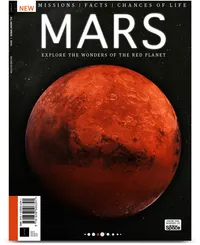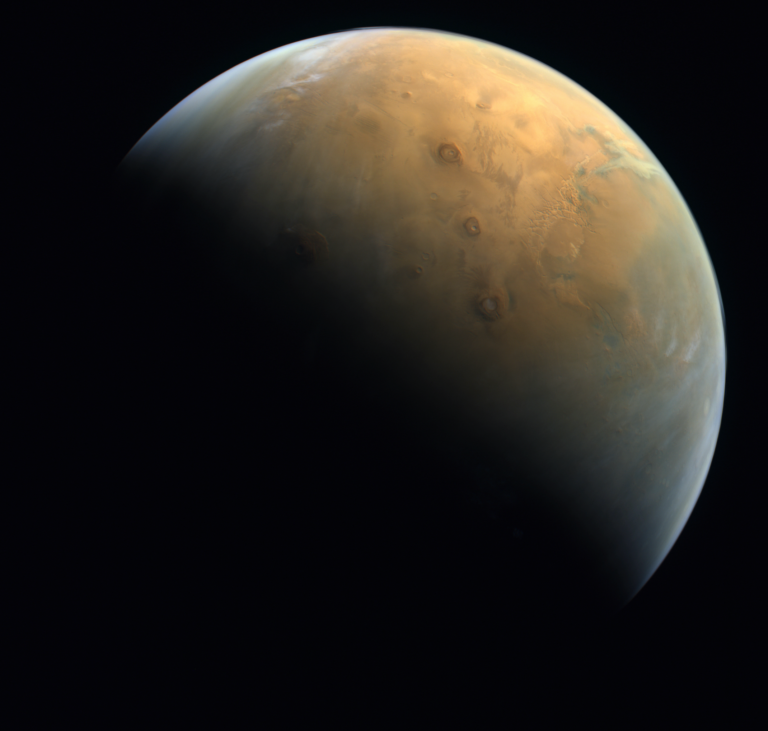Behold! See the 1st Mars closeup from UAE's Hope orbiter (photo).
Just one day after arriving in orbit around Mars, the United Arab Emirates' (UAE) first interplanetary spacecraft, Hope, captured a stunning photograph of the Red Planet.
The new photo, which is the first since Hope's arrival in Mars orbit on Feb. 9, shows a smattering of clouds, four massive Martian mountains and the vast Valles Marineris — the largest canyon in the solar system — in the right side of the image.
"We couldn't have asked for a better day on Mars!" UAE Space Agency chairperson Sarah Al Amiri wrote in a tweet Sunday (Feb. 14). "Can't wait to see the science data come in so we can comprehensively characterize the lower atmosphere!"
Related: The UAE's Hope Mars mission in photos
Book of Mars: $22.99 at Magazines Direct
Within 148 pages, explore the mysteries of Mars. With the latest generation of rovers, landers and orbiters heading to the Red Planet, we're discovering even more of this world's secrets than ever before. Find out about its landscape and formation, discover the truth about water on Mars and the search for life, and explore the possibility that the fourth rock from the sun may one day be our next home.
The Hope spacecraft launched in July 2020, bound to study the weather and atmosphere of the Red Planet. Hope successfully executed a perilous 27-minute thruster burn on Feb. 9 to slip into orbit around Mars, making the UAE the fifth entity to visit the Red Planet. (China became the sixth the next day with its Tianwen-1 mission.)
On board are three different instruments, one of which is a camera dubbed the Emirates Exploration Imager (EXI). It's EXI that snapped the new photograph, on Feb. 10 at 3:36 p.m. EST (2036 GMT). At the time, the spacecraft was about 15,300 miles (24,700 kilometers) above the planet's surface.
Easiest to spot in the new image are the trio of mountains marching across the image: from top to bottom, Ascraeus Mons, Pavonis Mons and Arsia Mons. Tricker to pick out is the massive Olympus Mons, the largest mountain in the solar system, seen at sunrise right along the line where night and day meet. To the right of the line of peaks is the vast canyon system Valles Marineris.
Breaking space news, the latest updates on rocket launches, skywatching events and more!
Related: The UAE wants to rewrite what we know about weather on Mars
Throughout the image is precisely what Hope went to Mars to study: the Red Planet's atmosphere. EXI and the two other instruments, which measure infrared and ultraviolet light, will gather the data scientists need to understand the planet's weather around the globe and throughout the day, and to piece together how the layers of the atmosphere interact with each other.
"Look at all the clouds," Andrew Jones, instrument scientist for EXI at the University of Colorado Boulder's Laboratory for Atmospheric and Space Physics, which partnered with the UAE on the mission, said in a statement. "We were expecting great things from EXI, but seeing the clouds above the limb and in the craters and valleys took my breath away."
Hope will remain in an initial orbit for about two months before relocating to its final orbit and beginning its science observations later this spring.
Email Meghan Bartels at mbartels@space.com or follow her on Twitter @meghanbartels. Follow us on Twitter @Spacedotcom and on Facebook.

Meghan is a senior writer at Space.com and has more than five years' experience as a science journalist based in New York City. She joined Space.com in July 2018, with previous writing published in outlets including Newsweek and Audubon. Meghan earned an MA in science journalism from New York University and a BA in classics from Georgetown University, and in her free time she enjoys reading and visiting museums. Follow her on Twitter at @meghanbartels.


